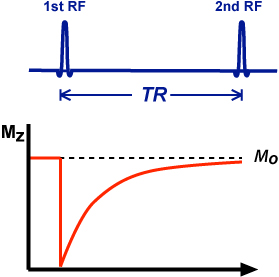Radiation
Radiation is the emission or transmission of energy in the
form of waves or particles through space or through a material medium.
Electromagnetic radiation
Electromagnetic waves can, like
all waves, be characterized by their
amplitude, wavelength (λ), frequency (ν) and speed. The
amplitude is the
intensity of the wave. The
wavelength is the distance between identical points on
adjacent cycles. The frequency is
the number of complete wave oscillations per
unit time. The speed of the wave
is equal to the product of the frequency and the
wavelength, and its magnitude
depends upon the nature of the material through
which the wave travels and the frequency of the
radiation. In a vacuum, however,
c = λν
For X rays, wavelength is usually
expressed in nanometres (nm)
(1 nm = 10-9 m) and frequency is
expressed in Hertz (Hz) (1 Hz = 1 cycle/s = 1 s–1).
When interactions with matter are
considered, electromagnetic radiation is
generally treated as series of
individual particles, known as photons. The energy
of each photon is given by:
E = hν
where the constant h is known as Planck’s constant. In
diagnostic radiology, the
photon energy is usually
expressed in units of keV, where 1 electronvolt (eV) is
the energy received by an
electron when it is accelerated across of a potential
difference of 1 V.
Particulate radiation
In diagnostic radiology, the only
particulate radiation that needs to be
considered is the electron. This
has a rest mass of 9.109 × 10–31 kg and a rest
energy of 511 keV.
Ionizing and non-ionizing radiations
Radiation is classified as
ionizing or non-ionizing, depending on its ability
to ionize matter:
●●Non-ionizing radiation cannot
ionize matter.
●● Ionizing radiation can ionize
matter, either directly or indirectly:
——Directly ionizing radiation: Fast charged
particles that deposit their
energy in matter directly,
through many small Coulomb (electrostatic)
interactions with orbital
electrons along the particle track.
——Indirectly ionizing radiation: X or gamma ray
photons or neutrons that
first transfer their energy to
fast charged particles released in one or a
few interactions in the matter
through which they pass. The resulting
fast charged particles then
deposit their energy directly in the matter.
The minimum energy required to
ionize an atom, i.e. to remove an electron,
is known as the ionization
potential. For elements, its magnitude ranges from a
few electronvolts for alkali
metals to 24.5 eV for helium. For water, it is 12.6 eV.
Electromagnetic radiation of
frequency higher than the near-ultraviolet region
of the electromagnetic spectrum
is ionizing, whereas electromagnetic radiation
with energy below the
far-ultraviolet region (e.g. visible light, infrared and
radiofrequency) is non-ionizing.




Comments
Post a Comment